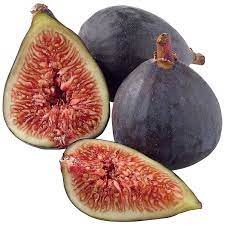Figs Fruits

Fig trees grew in all areas of Palestine. They provided two or three crops per year. Fig leaves were used as coverings. Figs were usually eaten fresh from the trees, but some were pressed into cakes to use when traveling. Figs were also valuable for medicinal purposes. The fig tree could be used for dwelling safely. The blighted fig tree symbolized the sin of Israel national peril. The fig was used as an example of faith, it became a symbol for the Jews living in the day of Jesus, it became a symbol of the end of time.
Fig leaves were used as coverings. Adam and Eve sewed fig leaves together and made themselves aprons when their eyes were open, and they knew they were naked. (Genesis 3:7).
The cultivation of fig trees was an ancient practice, common already in Canaanite times in Palestine. The fig tree produces fruit almost ten months of the year. (Numbers 13:23).
There are no figs, or of vines, or of pomegranates; nor is there any water to drink in the desert of Zin in the first month: and the people abode in Kadesh. (Numbers 20:1-5).
The fig tree was greatly honored among the children of Israel. Along with the olive tree and grave vine it symbolized the great abundance of the Promised Land. A land of wheat, and barley, and vines, and fig trees, and pomegranates; a land of oil olive, and honey. (Deuteronomy 8:8).
Figs were usually eaten fresh from the trees, but some were pressed into cakes to use when traveling. (1 Samuel 25:18; 30:12; 1 Chronicles 12:40).
The fig tree could be used for dwelling safely. The ample thick foliage of the fig tree provides a welcome refuge from the sun. Thus to sit beneath a fig tree became a symbol of life that was secure and blessed. “And Judah and Israel dwelt safely, every man under his vine and under his fig tree, from Dan even to Beersheba, all the days of Solomon.” (1 Kings 4:24-25).
Figs were also valuable for medicinal purposes. The prophet Isaiah took a lump of figs and laid it on a boil of Hezekiah. Hezekiah was healed by the LORD. (2 Kings 20:7; Isaiah 38:21).
Those who keeps the fig tree shall eat fruit from it and he that waits on or looks after his master will be honored. (Proverbs 27:18).
Isaiah and Nahum speak of cities that are “ripe” for destruction. Isaiah announces that Samaria is like “a fig ripe before harvest—as soon as someone sees it and takes it in his hand, he swallows it” (Isaiah 28:4).
Nahum 3:12 Nahum announces the falling of Nineveh “All thy strong holds shall be like fig trees with the first ripe figs: if they be shaken, they shall even fall into the mouth of the eater. “
Ripe figs that were not eaten, would eventually shrivel up and fall from the tree. The host of heaven shall be dissolved, and the heavens shall be rolled together as a scroll. All their host shall fall down, as the leaf falls off from the vine, and as a falling fig from the fig tree. Revelation reveals the stars of heaven fell unto the earth, even as a fig tree castes her untimely figs, when she is shaken of a mighty wind. (Isaiah 34:4; Revelation 6:13).
The prophet Jeremiah in his vision of the baskets of figs, spoke of those who had gone into exile as being like the fig that were first ripe, while those who were left behind were the naughty figs which could not be eaten, they were so bad figs. The evil figs were very evil, that cannot be eaten, and they are so evil. They are fit only for destruction. (Jeremiah 24:1–10). The blighted fig tree symbolized the sin of Israel national peril. (Jeremiah 5:17; Hosea 2:12; Joel 1:7-12, 12; Amos 4:9). Jeremiah 8:13 refers to the LORD that will consume and there shall be no grapes on the vine, nor figs on the fig tree, and the leaf shall fade; and the things that I have given them shall pass away from them.
The prophet Hosea suggested that the Israelites were like the first fruits of the fig tree. (Hosea 9:10).
The LORD God is jealous for his land, and has pity for His people. The
LORD God said unto His people He would be given corn, and wine, and oil, and you shall be satisfied therewith: and I will no more make you a reproach among the heathen. I will remove far off from you the northern army, and will drive him into a land barren and desolate, with his face toward the east sea, and his hinder part toward the utmost sea, and his stink shall come up, and his ill savour (that is Strong #06709 putrefy or stench, foul odor) shall come up, because he has done great things. We are told the land should not feat but be glad and rejoice for the LORD God will do great things. The beasts of the field should not be afraid; for the pastures of the wilderness do spring, for the tree bears her fruit, the fig tree and the vine do yield their strength. The children of Zion, or Jerusalem, are to rejoice in the LORD your God because He has given the former rain moderately, and he will cause to come down for them the rain, the former rain, and the latter rain in the first month. (Joel 2:18-23).
The LORD struck with a blasting and mildew at the time when their gardens and their vineyards and their fig trees and their olive trees increased, the palmerworm devoured them: Yet they still had not returned unto the LORD. (Amos 4:9).
Sycamore trees produced small, fig like fruit eaten primarily by the poor. A short time before harvest, the fruit was slightly scored, making it swell and ripen more quickly. The prophet Amos notched sycamore fruit before his calling. (Amos 7:14).
The fig tree provide ample shade where none shall be afraid. (Micah 4:4; Zech. 3:10).
Finally, it was Jesus’ frustration with the hypocrisy he saw in the leaders of Jerusalem that led Him to curse a fig tree on his way into this city. Jesus had spent the night in Bethany and in the morning, on His way into Jerusalem, He spied a fig tree boasting the leaves of early spring. However there were no figs on the tree. Jesus said unto it, Let no fruit grow on thee henceforward forever. And presently the fig tree withered away. Jesus used this as a warning for us all if you have faith, and doubt not, you shall not only do this which was done to the fig tree, but also if you shall say unto this mountain, Be thou removed, and be you cast into the sea; it shall be done. (Matthew 21:18–21; Mark 11:12, 13, 20, 21).
Just before the winter rainy season the fig sheds its leaves; new shoots sprout in March or April, signaling the coming of summer. Jesus used this as a parable of the fig tree; when her branches are yet tender, and puts forth eaves you know that summer is near. This generation shall not pass, till all these things be fulfilled. Heaven and earth shall pass away, but words of Jesus shall not pass away. But of that day and hour no man, nor the angels of heaven know but only His Father. (Matthew 24:3236; Mark 13:28).
The fig tree became a symbol for the Jews living in the day of Jesus who had failed to accept him as the Messiah. A fig tree that was planted and carefully tended was expected to bear fruit within a reasonable amount of time. The parable told by Jesus, a man had planted a tree, tended it, and waited for three years, anticipating that it would produce fruit. When the tree had not produced fruit the man told the dresser of the vineyard to cut it down and use the space for something else. But the dresser of the vineyard asked that it be given one more year of caring for it. Then if it bears fruit well; and if it does not bear fruit then it shall be cut down. (Luke 13:6–9).
The changes in season are marked by the budding appearance of the fig tree. The appearance of small leaves and the presence of early season figs signal the onset of spring (Luke 21:29–30).
Philip rushed to tell Nathanael about Jesus. It was important to Jesus that we notice where Nathanael was sitting when this “true Israelite, in whom there is nothing false,” heard the news about Jesus. Twice Jesus mentioned Nathaniel sitting underneath a fig tree. (John 1:47-50).
Cite Article Source
MLA Style Citation:
Holstein, Joanne “Figs Fruits:.” Becker Bible Studies Library Feb 2015.< https://guidedbiblestudies.com/?p=2370,>.
APA Style Citation:
Holstein, Joanne (2015, February) “Figs Fruits:.” Becker Bible Studies Library. Retrieved from https://guidedbiblestudies.com/?p=2370,.
Chicago Style Citation:
Holstein, Joanne (2015) “Figs Fruits:.” Becker Bible Studies Library (February), https://guidedbiblestudies.com/?p=2370, (accessed).


